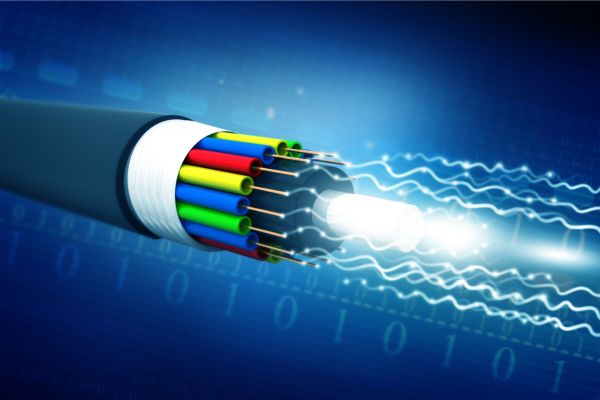In today’s digital age, the demand for fast, reliable internet connectivity has never been greater. From businesses relying on cloud computing to individuals streaming high-definition content or participating in video calls, the internet is central to daily life. Traditional broadband connections often struggle to meet these demands, leading to slow speeds and unstable connections. Enter fiber optic internet — a game-changer in high-speed connectivity.
Fiber optic internet has revolutionized the way we connect, offering faster speeds, lower latency, and greater reliability. According to a report by the Fiber Broadband Association, fiber optic broadband can deliver speeds up to 100 times faster than traditional broadband connections, making it ideal for modern-day internet usage. This technology is transforming how we interact with the digital world, powering everything from remote work to online entertainment. But what makes fiber optics so different, and why is it considered the future of internet connectivity?

What is Fiber Optic Internet?
Fiber optic internet is a type of broadband connection that uses light to transmit data through fiber optic cables. Unlike traditional copper cables that rely on electrical signals, fiber optics carry data as light pulses, which travel at incredibly high speeds. This allows fiber optic internet to deliver faster speeds over longer distances with minimal loss of quality.
Fiber optic technology is vastly different from older types of broadband internet, like DSL or cable. While DSL and cable internet are limited by the electrical signals transmitted through copper wires, fiber optics allow for higher bandwidth and more reliable connections, which is essential as our internet usage continues to grow. According to a study by the National Cable & Telecommunications Association, fiber optic networks can handle up to 100Gbps (gigabits per second), while traditional cable networks are typically limited to 10Gbps.
How Fiber Optic Internet Works
The magic behind fiber optic internet lies in the science of light transmission. Fiber optic cables consist of thin strands of glass or plastic that transmit light signals. These signals are sent through the cable using total internal reflection, a process where light bounces off the inner walls of the cable without escaping. This enables the signal to travel over long distances without significant loss of quality.
There are two main types of fiber optic cables: single-mode fiber and multi-mode fiber. Single-mode fiber has a smaller core and is designed for long-distance communication, while multi-mode fiber has a larger core and is used for shorter distances, typically within buildings or data centers.
At the source and destination of the fiber optic network, specialized transmitters and receivers convert electrical signals into light and vice versa, ensuring smooth communication across the network.
Advantages of Fiber Optic Internet
Faster Speeds
One of the most significant advantages of fiber optic internet is its speed. Fiber optics can deliver download and upload speeds that far surpass those of traditional broadband connections. This is especially important in today’s world, where activities like video streaming, gaming, and large file transfers require fast and stable internet connections.
According to a report by Speedtest.net, fiber optic internet can provide download speeds of up to 1,000 Mbps (1Gbps), compared to average cable internet speeds of just 100 Mbps. With fiber optics, users can experience seamless streaming of 4K videos, smooth online gaming, and fast downloads, all without buffering or slowdowns.

Lower Latency
Fiber optic internet also provides much lower latency compared to other types of broadband connections. Latency refers to the delay in data transmission between the sender and the receiver. Studies have shown that fiber optic networks can have latencies as low as 2 milliseconds, compared to the 30-50 milliseconds of latency found in cable or DSL networks.
With fiber optics, data can be transmitted almost instantaneously, making it ideal for real-time applications such as video calls, online gaming, and remote work. The low latency of fiber optics ensures smooth communication and a better overall user experience.
Greater Bandwidth
Fiber optic internet offers much higher bandwidth than traditional internet connections. This means it can handle more data at once, allowing multiple devices to connect to the internet without experiencing slowdowns. Whether it’s streaming videos on multiple devices, attending virtual meetings, or downloading large files, fiber optic internet can handle heavy traffic with ease. For businesses, this translates into better efficiency and productivity, as they can rely on a fast, stable internet connection to support their operations.
Reliability and Stability
Fiber optic internet is known for its reliability and stability. Unlike copper cables, fiber optics are not susceptible to interference from weather, electrical signals, or electromagnetic noise. A survey by the National Fiber Optic Broadband Association found that fiber optic networks have a failure rate of less than 0.1%, compared to 4-6% for copper-based networks.
This makes fiber optic internet more consistent, ensuring fewer outages and disruptions. Whether it’s during a thunderstorm or in remote locations, fiber optics continue to deliver a stable connection, making it a preferred choice for both residential and business use.

The Role of Fiber Optic Internet in Supporting Business Growth
Fiber optic internet is not only transforming the way individuals experience the internet, but it’s also playing a crucial role in business growth. For companies, a fast and reliable internet connection is essential for supporting activities like cloud computing, video conferencing, and accessing large datasets.
Small businesses, startups, and large corporations alike benefit from fiber optic connections. According to a report from the US Chamber of Commerce, 82% of businesses with fiber optic internet reported an increase in productivity due to improved speeds and reliability. For example, a startup in the tech industry might rely on fiber optics for smooth communication with clients and partners, while a large corporation might use the bandwidth to host secure cloud-based services for employees working remotely.
How Fiber Optics Are Shaping the Digital Economy
Fiber optic internet is a driving force behind the growth of the digital economy. As industries increasingly rely on digital platforms for commerce, education, healthcare, and communication, the need for high-speed internet has become critical.
In e-commerce, fiber optics enable businesses to run online stores with minimal lag time, ensuring that customers have a smooth shopping experience. In telemedicine, fiber optics provide the bandwidth needed for high-quality video consultations between doctors and patients. Educational institutions are also benefiting from fiber optics, as they can offer online courses, virtual classrooms, and collaborative projects without worrying about connectivity issues.
Furthermore, fiber optic internet is vital for the expansion of the Internet of Things (IoT), smart cities, and remote work. With more devices connected to the internet, the need for high-bandwidth connections becomes even more pronounced. Fiber optics provide the infrastructure that supports these technologies, enabling real-time data transmission and connectivity across networks.
Fiber Optic Internet is Evolving Connectivity
Fiber optic internet is playing a pivotal role in the evolution of high-speed connectivity. By offering faster speeds, lower latency, and greater bandwidth, fiber optics are empowering individuals, businesses, and entire industries to thrive in an increasingly connected world. As the demand for faster, more reliable internet continues to rise, fiber optic technology is poised to be at the forefront, shaping the future of digital communication and the global economy.




